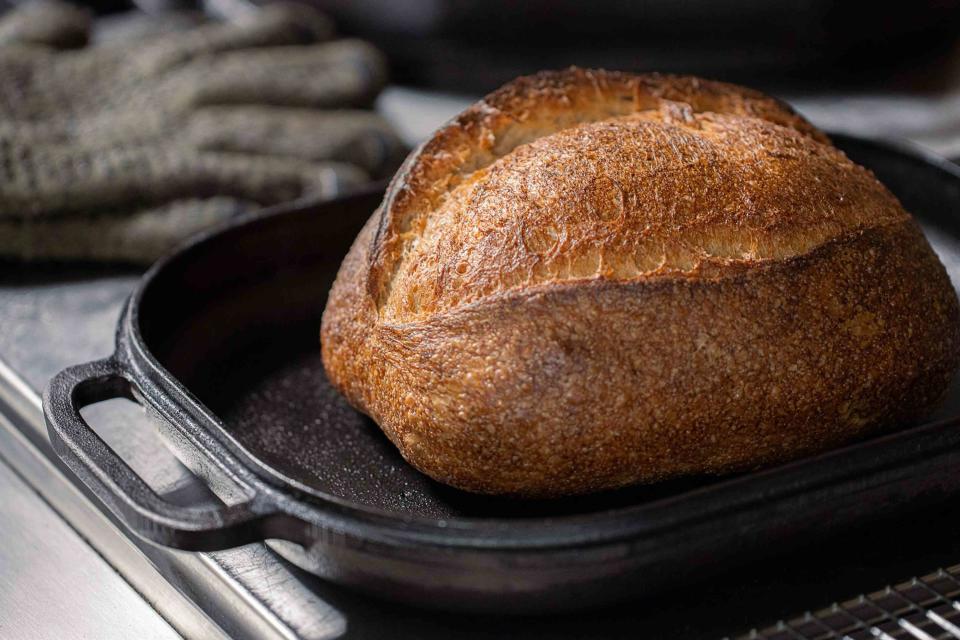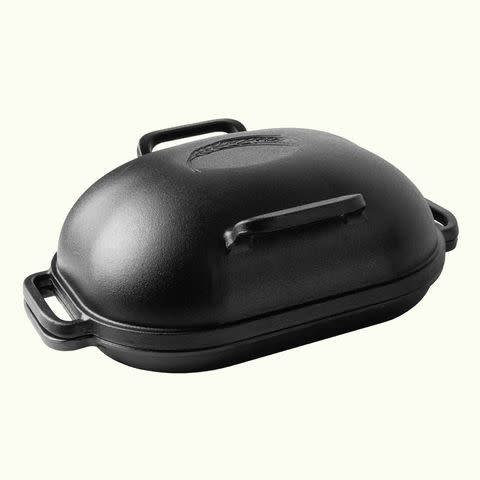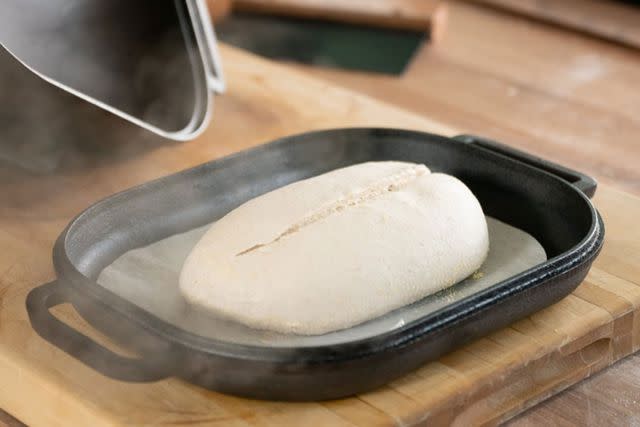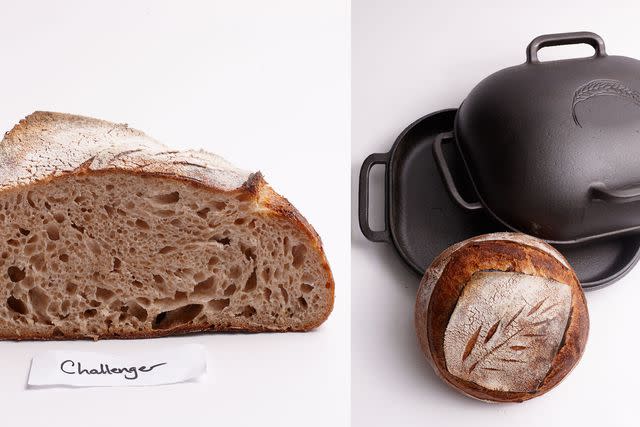The Challenger Bread Pan Has Transformed My Homemade Bread Loaves
Dotdash Meredith and Yahoo Inc. may earn commission or revenue on some items through the links below.
This pan will change your boules for the better.

Challenger Breadware
I hear the same things whenever I tell somebody I make sourdough bread: I could never do that. It's too many steps. I used to say the same thing, having never been much of a baker and always more of a cook since I like to use all my senses, and can sometimes be lazy. Like many people, I had more time at home during the pandemic and found myself with a dollop of sourdough starter that a friend made from Nancy Silverton's recipe using grapes. Soon enough, making sourdough became meditative.
The deeper I delved, the more I saw cooks making better-looking bread than me talking about the Challenger Bread Pan. The price felt steep at $299 and it seemed hard to justify that as a new baker, but my husband gifted it to me in 2021. The decision was made for me, and I am so glad. Challenger Breadware’s reputation precedes it — it is one of the most popular bands for bread-baking enthusiasts and professionals. After using the Challenger pan for two years, I can attest that it is indeed “designed by and made for bakers” and yields the perfect loaf results to back up its claims.

Price at time of publish: $299
Dimensions: 15.4” L x in 10.5” W x 5.4” H
Weight: 22 pounds
Material: cast iron
How We Used the Challenger Bread Pan
After owning the Challenger pan for over two years and making over 50 loaves of sourdough bread, I've learned a few things and developed a strong opinion. The Challenger absorbs, retains, and radiates heat, so you can get a good crust and enviable crumb no matter which loaf style you love. The rectangular pan has a large lid with substantial handles (large enough to wear oven mitts) so you can maneuver it safely and easily. The Challenger sells a highly heat-resistant model since bread often needs to cook at up to 500°F. Baking stones and Dutch ovens can have limitations, but this bread-baking vessel design mimics a range within an oven. Since it's made from cast iron, it will last for generations and perform better than any other material for baking bread.
What We Love About the Challenger Bread Pan
I love this bread pan’s design. Other tools I've used have limitations because of size, yet this rectangular format enables me to bake all different bread shapes, whether batards or boules. I also like that the design allows plenty of clearance between your parchment and the edge. Even if I'm sloppy closing the lid because of multi-tasking, the weight tends to make it settle in place, so steam occurs no matter what. I especially like how the top serves as an upturned base after the first half of cooking, so your bread doesn't get overly browned on the bottom. I can overturn my proofing basket directly onto the bottom, so I don't have to transfer it back and forth from the oven to the counter. The oblong base also enables me to score my loaves on the pan without worrying that I will burn myself.

Food & Wine / Challenger Breadware
Setting up a loaf for baking in the ChallengerThe Caveats
The Challenger Bread Pan is not for casual users. It’s ideal for seasoned home bakers who find the conventional oven is insufficient for the crackly crusts they aspire to. This pan is hefty, weighing in at 22 pounds thanks to the solid cast iron construction. If mobility is a concern, opt for a smaller tool like a Dutch oven or one of the other bread cloches we recommend. I always keep mine out on the range, eliminating any problems lifting it in and out of cabinets.
Tips and Tricks
Heat the pan for an hour at 500° before baking your bread for the best results.
Add one or two ice cubes to the first half of your cook to create steam that rivals a steam oven.
After the first two 20 minutes of cooking, remove and invert the lid. Place the shallow base on the inverted top and continue baking until your bread reaches the desired temperature. Challenger provides detailed videos and instructions on how to do so.
The Challenger comes pre-seasoned, but you need to season it just as you would a cast iron pan after every use.
Challenger has an extensive online database of advice for using the bread pan, from forming a loaf to seasoning after you bake. They even have a fun section on how to do decorative scoring. We also have great tutorials on making sourdough bread should you need a refresher or have more questions about bread-baking tools.

How It Compares
I often baked two loaves at once since I have two ovens and often tested this bread pan against my Emile Henry Cloche. The seal and results on The Challenger were hands down better than any results I received achieved with my Emile Henry Cloche or any of my Dutch ovens, and it's simply a superior pan.
If the price is too much, the closest Challenger Bread Pan alternative is the Lodge Cast Iron Combo Cooker.
The Verdict
After using the Challenger Bread Pan to bake countless sourdough loaves over the past two years, I can attest it is a great buy that does what it says. It transformed the quality of my bread in my conventional home oven and mimicked the same effects as a commercial oven if used correctly. It has made me bake my best bread ever.
Shipping
Challenger Breadware ships worldwide and offers free shipping on orders over $99 in the contiguous United States.
For more Food & Wine news, make sure to sign up for our newsletter!
Read the original article on Food & Wine.

